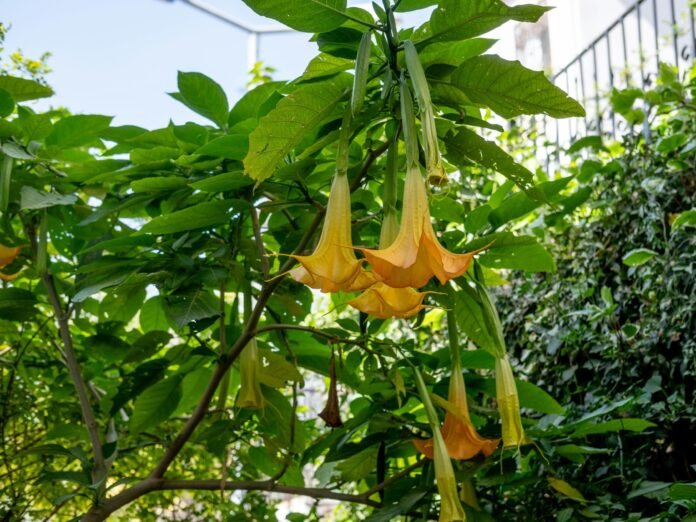Also known as: Angel Star, Angel’s Tears, Brazil’s White Angel Trumpet, Cornucopia, Datura, Devil’s Trumpet, Downy Thorn-apple, Hindu Datura, Hindu Thorn-apple, Hoary Thorn-apple, Horn-of-plenty, Jimson Weed, Metel, Night Bells, Queen of the Night, Snowy Angel’s Trumpet, Thorn Apple, Trumpet Flower and White Angel’s Trumpet
Family: Solanaceae
Origin: Southeastern Brazil
(Nifty Nugget of Knowledge: Angel Trumpets are closely related to the eggplant, petunia, potato, tobacco, and tomato – but, judiciously consider the following!)
This guy’s no addition for the pantry with absolutely no culinary uses whatsoever. It’s a showy “Look at me” bloomer and a hybrid of two Brugmansia species, B. aurea and B. versicolor. Its striking, often fragrant (especially at night, attracting moths for pollination) blossoms are admired and appreciated for their large, pendulous, trumpet-shaped flowers.
But before proceeding further, I feel it vital to repeat what I wrote about this plant in Volume I of The Medicinal Jungle series, “At best, eating the flower will result in terrifying hallucinations; at worst, it can leave you dead.” So. I’d rather strongly encourage you cancel those baking plans for Angel’s Trumpet Tarts!
This member of the nightshade family is considered by some botanists as the most poisonous plant of all tropical plants! All of its parts are potentially poisonous, with the seeds and leaves being particularly dangerous. They are rich in scopolamine (hyoscine), hyoscyamine, and several other tropane alkaloids which can lead, at the minimum, to delirium . . . and that’s no cozy, little New England coastal village!
All of its parts are highly toxic if ingested, and the sap can cause skin irritation. It contains scopolamine and atropine, which can have dangerous effects on the central nervous system. However, that is no reason not to enjoy viewing its magnificent florescence. Just as no untouched gun ever shot anyone, problems only occur with human intervention! (Aha, a most logical epiphany of sorts in that a huge percentage of the world’s problems and difficulties have been the result of mankind’s bad judgment!)
That all duly noted for further pondering, Brazilian natives have smoked the leaves to achieve relief from asthma. . . but then, again, there is that pesky side effect of strong narcotic effects! A bit relative thereto, I’ve also read that a tea brewed from the leaves has been used as a relaxing beverage, though – well duh! – with the risk of severe toxicity, if not prepared properly. Furthermore, and an obvious and most logical statement of simple, good sense – though known to happen – the recreational use of Angel’s Trumpet as a drug, is extremely dangerous due to the difficulty in estimating the dosage of its toxic alkaloids.
However, in spite of that, ethnopharmaceutically, other South American cultures have used it – in diluted preparations – for aches, arthritis, burns, dermatitis, headaches, infections, inflammation, rheumatism, and skin irritation, as well as to treat stomach and muscle ailments, to induce vomiting, and as a sedative. Citing particular plant parts, its leaves have traditionally been employed in treating abscesses, fungal infection of the skin, swelling, sores, ulcers, and wounds that don’t heal for a long time.
Further sources state that the plant’s hyoscine – also known as scopolamine – is used to treat nausea and to stem saliva production.
Yet again, at the sake of repeating myself, be aware that ingestion of any parts of the Angel’s Trumpet can lead to severe anticholinergic effects such as hallucinations, paralysis and/or psychosis – if not the more permanent meeting of one’s demise! But yet, of a more contemporary, “next door,” nature, its tropane alkaloids have been incorporated – in minute amounts, mind you – on patches for motion sickness!
Perhaps, cautious, core counsel with all things considered, might be to simplythink of who all will be viewing and around your Angel’s Trumpet, as accidental poisoning can occur, particularly of small children and pets.
After full and complete consideration, what of their application and inclusion in your garden? They’ve large, velvety leaves surrounding showy flowers of green (I’ve not yet seen nor have one of these), orange, pink, red, white, or yellow. These potentially deadly beauties may grow to large shrubs or small trees of ten to thirty-six feet. (This surprised me as well when I first learned it and added some to our Ola Brisa Gardens plant family – which have been visited by thousands of adults only, without pets).
However, remember, they can easily be kept smaller through pruning.
The decision is yours to make!


